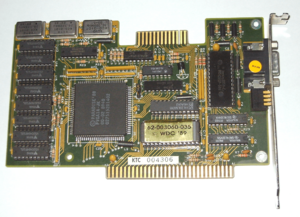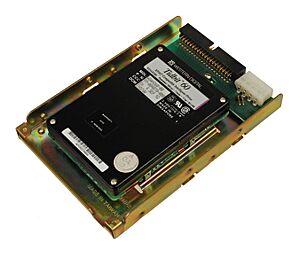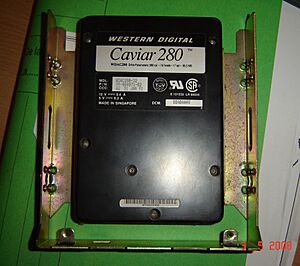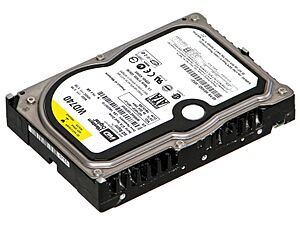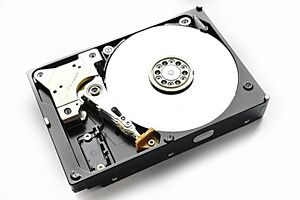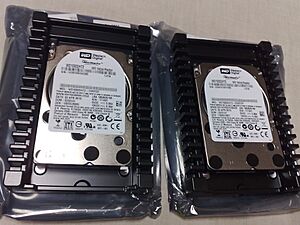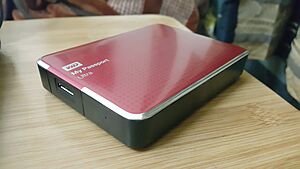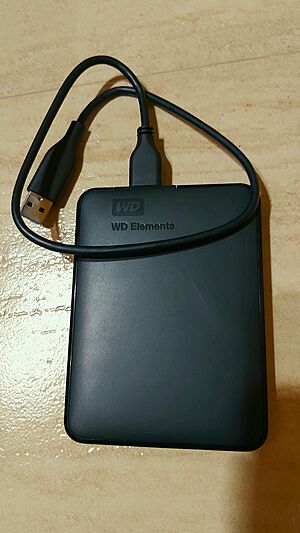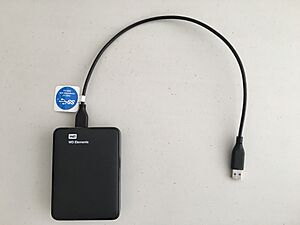Western Digital facts for kids
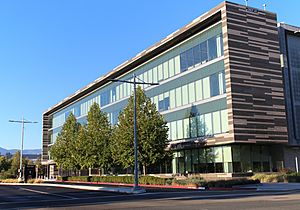
Headquarters in the Santa Teresa district of San Jose, California in 2021
|
|
|
Formerly
|
General Digital Corporation (1970–1971) |
|---|---|
| Public | |
| Traded as | |
| Industry | Computer data storage |
| Founded | April 23, 1970 in Newport Beach, California |
| Founder | Alvin B. Phillips |
| Headquarters |
,
U.S.
|
|
Area served
|
Worldwide |
|
Key people
|
Irving Tan (CEO) |
| Products |
|
| Brands |
|
| Revenue | |
|
Operating income
|
▲ US$-317 million (2024) |
| ▲ US$-798 million (2024) | |
| Total assets | |
| Total equity | |
|
Number of employees
|
51,000 (2024) |
| Footnotes / references Financials as of June 28, 2024[update] |
|
Western Digital Corporation is an American company that makes and sells computer storage devices. Its main office is in San Jose, California. The company started in 1970 and is one of the world's biggest makers of hard disk drives (HDDs).
Contents
History of Western Digital
Early Years (1970s)
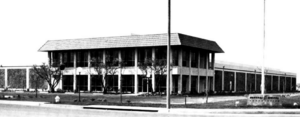
Western Digital began on April 23, 1970. It was first called General Digital Corporation. The company started by making special equipment for testing computer chips. It was founded by Alvin B. Phillips, who used to work at Motorola.
The company quickly became known for making semiconductor chips. In 1971, it changed its name to Western Digital. Soon after, it released its first product, a chip called the WD1402A UART.
In the early 1970s, Western Digital focused on making chips for calculators. By 1975, it was the world's largest independent maker of calculator chips. However, a big economic problem in the mid-1970s and the failure of a major customer caused the company to face financial trouble. In 1976, Western Digital had to declare bankruptcy.
After this, the company started making chips for floppy disk drives. One important chip was the FD1771. This chip helped control floppy disk drives and was a big step for Western Digital in the data storage world.
Growth in the 1980s
The success of the FD1771 chip led Western Digital into the data storage business. By the early 1980s, they were making controllers for hard disk drives. In 1983, they got a big contract to provide controllers for IBM's PC/AT computers.
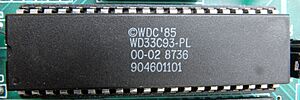
The WD1003 controller became the basis for the ATA interface. This interface is a standard way for computers to connect to storage devices. For most of the 1980s, these controllers brought in most of Western Digital's money.
During this time, Western Digital also bought other companies. They started making graphics cards (like the popular Paradise VGA cards), chips for computer motherboards, and SCSI controller chips. In 1988, Western Digital bought the hard drive making parts of Tandon Corporation. This was a huge change, as it meant Western Digital would now make its own hard drives.
Innovations and Challenges (1990s)
By 1991, Western Digital launched its Caviar drives. These were new hard drive designs that used advanced technology. The Caviar drives sold very well.
Because of the success of Caviar drives, Western Digital started selling off some of its other divisions. For example, their graphics card business was sold. Around 1995, other companies started making better hard drives, and Western Digital faced tough competition.
In 1998, Western Digital teamed up with IBM to improve its drives. This agreement allowed Western Digital to use IBM's advanced technologies, like GMR heads. This helped Western Digital make better drives, like the Expert line, and regain its good reputation.
New Technologies (2000s)
In 2001, Western Digital was the first to offer mainstream hard drives with 8 MiB of disk buffer. This was a lot more than the usual 2 MiB at the time. These drives were called "Special Edition" and were good for file servers.
In 2003, Western Digital bought parts of Read-Rite Corporation, a company that made parts for hard drives. In the same year, Western Digital released the first 10,000 rpm Serial ATA hard drive, called the "Raptor". These drives were very fast. Later, they released bigger and quieter versions of the Raptor.
In 2006, Western Digital introduced its My Book line of external hard drives. These drives had a unique book-like design. In 2007, they released a 1 TB My Book drive, which was very large for the time.
Western Digital also started making energy-efficient drives called GP (Green Power) drives. These drives were designed to save energy.
In 2008, Western Digital launched the next generation of its fast drives, called WD VelociRaptor. These drives were even faster and had a special cooling system. They also shipped the first 500 GB hard drive for laptops.
By 2009, Western Digital shipped the first 2 TB internal hard drive. They also entered the solid-state drive (SSD) market by buying Siliconsystems, Inc. Later that year, they released the first 1 TB mobile hard drive.
Modern Era (2010s and 2020s)
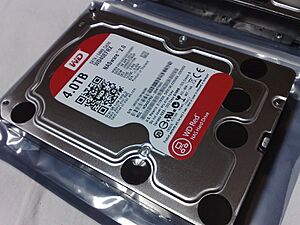
In 2011, Western Digital agreed to buy parts of Hitachi's storage unit, called HGST. This deal was completed in 2012, making Western Digital the largest traditional hard drive maker in the world. To meet government rules, Western Digital sold some of its hard drive factories to Toshiba.
In 2013, Western Digital stopped making older types of hard drives called parallel ATA drives. They were the last company to still make them.
In 2014, Western Digital announced a new "Purple" line of hard drives. These drives are made for video surveillance systems, like security cameras. They are designed to handle constant video recording.
In 2016, Western Digital bought SanDisk for a large sum of money. SanDisk is famous for making flash memory products like USB drives and memory cards. This acquisition greatly expanded Western Digital's products beyond just hard drives.
In 2017, Western Digital moved its main office to San Jose, California. They also bought other companies that focused on cloud storage and flash memory systems. In October 2017, Western Digital shipped the world's first 14 TB hard drive.
In 2018, Western Digital announced plans to focus more on flash drive production. They closed one of their hard disk factories in Malaysia.
In 2020, Western Digital released a new consumer SSD called the WD Black SN850 1TB. This SSD was very fast and performed better than many others at the time.
In 2021, some users of older Western Digital My Book Live devices reported that their data had been erased. Western Digital advised users to disconnect these devices from the internet.
In February 2022, Western Digital and its partner Kioxia reported that contamination issues affected their flash memory factories in Japan. This caused a loss of a large amount of memory output.
In March 2023, Western Digital experienced a cyberattack. The company took some services offline to investigate. The attackers claimed to have taken a lot of data and demanded money.
On February 24, 2025, Western Digital separated its flash memory business into a new company called Sandisk Corporation. This means Western Digital now focuses only on hard disk drives.
Western Digital Products
Western Digital makes hard drives for many different uses. These include drives for personal computers, security cameras, video game consoles, network-attached storage (NAS) devices, and set-top boxes. They also sell special hardware and software for large data centers.
Western Digital organizes its storage products into different brands, often using colors to show their intended use:
| Color/branding | Use case | HDD warranty length (years) | |
|---|---|---|---|
| WD Blue | General computing | 2 | |
| WD Purple | Surveillance | 3 | |
| WD Purple Pro | Surveillance | 5 | |
| WD Red | Small office/home office | 3 | |
| WD Red Plus | Small business, network-attached storage (NAS), and RAID | 3 | |
| WD Red Pro | High-performance network-attached storage | 5 | |
| WD_Black | High-performance and gaming | 5 | |
| WD Gold | Enterprise | 5 | |
| Ultrastar | Datacenter | 5 | |
| Internal use | External USB enclosures | 2 to 3 (together with drive enclosure) | |
WD Purple hard drives are made for tasks that involve a lot of writing data, like security cameras. These drives have special features to help reduce lost video frames.
External hard drives are sold under brands like My Passport, My Book, WD Elements, and Easystore. Western Digital also offered the WD TV series of products. These devices could play videos, images, and music from USB drives or network locations.
The My Cloud series of products from Western Digital act as home media servers. They let you store and share files between your computers and mobile devices.
Company Affairs
Western Digital Capital is the company's investment part. It helps fund other data technology companies.
Lawsuits and Disputes
Western Digital has faced lawsuits about how they describe the capacity of their drives. Hard drive makers use 1,000 bytes as a kilobyte, but most computer operating systems use 1,024 bytes. This difference can make it seem like a drive has less space than advertised. Western Digital said they used the correct industry standard. In 2006, they agreed to settle a lawsuit by offering refunds or software to affected customers.
In 2020, Western Digital was sued for using a technology called shingled magnetic recording (SMR) in some of its WD Red drives without clearly telling customers. This technology can be slower for certain uses, like in RAID arrays (which combine multiple drives). Another company, Seagate, said that SMR is not good for NAS (Network-attached storage) use. In response, Western Digital created the "Red Plus" brand for drives that use a different, faster technology, while "WD Red" drives use SMR and are for lighter use.
Companies Western Digital has Acquired
Western Digital has grown by buying other companies over the years. Here are some of the notable acquisitions:
- In 2003, they bought Read-Rite Corp, which made parts for hard drives.
- In 2007, they acquired Komag, a company that made hard disk media.
- In 2012, they completed the purchase of HGST, a major hard drive and SSD maker.
- In 2013, they bought sTec and Virident, both companies that made SSDs.
- In 2016, they acquired SanDisk, a very important purchase that brought them into the flash memory market.
- In 2017, they bought Upthere (cloud storage) and Tegile (flash storage systems).
See also
 In Spanish: Western Digital para niños
In Spanish: Western Digital para niños




